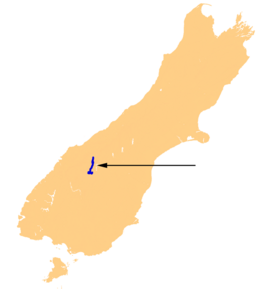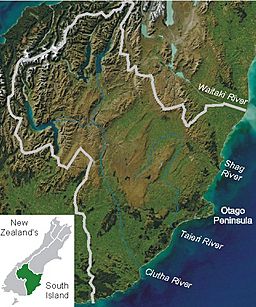Lake Wānaka facts for kids
Quick facts for kids Lake Wānaka |
|
|---|---|

View of Lake Wānaka from Mt. Roy.
|
|

Location on the South Island
|
|
| Location | Queenstown-Lakes District, Otago, South Island |
| Coordinates | 44°30′S 169°08′E / 44.500°S 169.133°E |
| Primary outflows | Clutha River / Mata-Au |
| Basin countries | New Zealand |
| Max. length | 42 km (26 mi) |
| Max. width | 10 km (6.2 mi) |
| Surface area | 192 km2 (74 sq mi) |
| Max. depth | est. 311 m (1,020 ft) |
| Surface elevation | 278 m (912 ft) |
| Islands | Harwich Island, Mou Tapu, Mou Waho, Ruby Island, Stevensons Island |
Lake Wānaka is New Zealand's fourth-largest lake and the seat of the town of Wānaka in the Otago region. The lake is 278 meters above sea level, covers 192 km2 (74 sq mi), and is more than 300 m (980 ft) deep.
"Wānaka" is the South Island dialect pronunciation of wānanga, which means "the lore of the tohunga or priest" or a place of learning.
Contents
Geography
Geography
Lake Wānaka lies at the heart of the Otago Lakes in the lower South Island of New Zealand. The township of Wanaka, which sits in a glacier-carved basin on the shores of the lake, is the gateway to Mt Aspiring National Park. Lake Hāwea is a 15-minute drive away, en route to the frontier town of Makarora, the last stop before the West Coast Glacier region. To the south is the historic Cardrona Valley, a popular scenic alpine route to neighbouring Queenstown.
Geology
Lake Wānaka lies in a u-shaped valley formed by glacial erosion during the last ice age more than 10,000 years ago. It is fed by the Matukituki and Makarora Rivers, and is the source of the Clutha River / Mata-Au.
At its greatest extent, which is roughly along a north–south axis, the lake is 42 kilometres long. Its widest point, at the southern end, is 10 kilometres. The lake's western shore is lined with high peaks rising to over 2000 metres above sea level. Along the eastern shore the land is also mountainous, but the peaks are somewhat lower.
Nearby Lake Hāwea lies in a parallel valley carved by a neighbouring glacier eight kilometres to the east. At their closest point (a rocky ridge called The Neck), the lakes are only 1000 metres apart.
Four small islands within the lake include Ruby Island, Stevensons Island, Mou Tapu and Mou Waho (Harwich) Island. Some host ecological sanctuaries, such as one for buff weka on Stevensons Island. Mou Tapu island is 120 hectares in size and is a pest free island. Mountain stone weta and the Southern Alps gecko can be found here.
The towns of Wanaka and Albert Town are near the lake's outflow into the Clutha / Mata-Au.
Climate
| Climate data for Lake Wānaka | |||||||||||||
|---|---|---|---|---|---|---|---|---|---|---|---|---|---|
| Month | Jan | Feb | Mar | Apr | May | Jun | Jul | Aug | Sep | Oct | Nov | Dec | Year |
| Average high °C (°F) | 23.9 (75.0) |
23.4 (74.1) |
20.8 (69.4) |
17.3 (63.1) |
12.2 (54.0) |
8.4 (47.1) |
8.4 (47.1) |
11.0 (51.8) |
14.4 (57.9) |
16.8 (62.2) |
19.8 (67.6) |
21.9 (71.4) |
16.5 (61.7) |
| Average low °C (°F) | 10.8 (51.4) |
10.4 (50.7) |
8.4 (47.1) |
5.1 (41.2) |
1.6 (34.9) |
−0.9 (30.4) |
−1.2 (29.8) |
−0.2 (31.6) |
2.4 (36.3) |
5.0 (41.0) |
7.3 (45.1) |
9.6 (49.3) |
4.9 (40.7) |
| Average precipitation mm (inches) | 56.9 (2.24) |
50.2 (1.98) |
60.7 (2.39) |
56.4 (2.22) |
62.7 (2.47) |
54.5 (2.15) |
52.2 (2.06) |
52.8 (2.08) |
56.4 (2.22) |
63.1 (2.48) |
54.7 (2.15) |
51.9 (2.04) |
672.5 (26.48) |
| Mean monthly sunshine hours | 231.5 | 201.7 | 182.6 | 164.0 | 135.5 | 120.5 | 126.6 | 155.8 | 172.5 | 193.8 | 202.2 | 212.1 | 2,098.8 |
| Source: http://www.lakewanaka.co.nz/content/library/Weather_data.pdf | |||||||||||||
Human history
Exploration and settlement
For Māori, the Wānaka area was a natural crossroads. The Haast Pass gave access to the West Coast and its pounamu; the Cardrona Valley led to the natural rock bridge "Whatatorere", which was the only place that the Kawarau River and Clutha River / Mata-Au could be crossed without boats. Native reeds were used to build mōkihi, small boats that enabled a swift return downriver to the east coast. The Cromwell basin supported a large population of moa, which were hunted to extinction about 500 years ago.
Until the early nineteenth century, Wānaka was visited annually by Ngāi Tahu who sought pounamu in the mountains above the Haast River and hunted eels and birds over summer, returning to the east coast by descending the Clutha River / Mata-Au in mōkihi reed boats.
According to the Ngāi Tahu, Lake Wānaka was dug by the Waitaha explorer Rākaihautū with his kō named Tūwhakaroria. After Waitaha arrived in the Uruao waka at Whakatū (Nelson), Rākaihautū divided his people into two groups. Rākaihautū led his group down the middle of the island, digging the freshwater lakes of Te Waipounamu.
Numerous kāinga mahinga kai (food-gathering places) and kāinga nohoanga (settlements) were located around the lake. The Kāti Māmoe settlement at the site of modern Wanaka was named Para karehu. The area was invaded by the Ngāi Tahu in the early 18th century.
Ngāi Tahu use of the land was ended by attacks by North Island tribes. In the last years of the Musket Wars, in 1836 the Ngati Tama chief Te Puoho led a 100-person war party, armed with muskets, down the West Coast and over the Haast Pass: they fell on the Ngāi Tahu encampment between Lake Wānaka and Lake Hāwea, capturing 10 people and killing and two children. Although Te Puoho was later killed by the southern Ngāi Tahu leader Tuhawaiki, Māori seasonal visits to the area ceased.
The first known map of Lake Wānaka was drawn in 1844 by the southern Ngāi Tahu leader Te Huruhuru. The first European to see the lake was Nathaniel Chalmers in 1853. Guided by Reko and Kaikoura, he walked from Tuturau (Southland) to the lake via the Kawarau River. However he was stricken by dysentery, so his guides returned him down the Clutha, shooting the rapids in a mōkihi reed boat.
By 1861, several sheep stations had been established in and around the south end of the lake, and in 1862, the lake itself was surveyed in a whaleboat. The early European name was Lake Pembroke.
Current use and tourism
In addition to ongoing sheep farming, the lake is now a popular resort, and is much used in the summer for fishing, boating and swimming. The nearby mountains and fast-flowing rivers allow for adventure tourism year-round, with jetboating and skiing facilities located nearby.
With Queenstown airport close by, tourism mirrors that of the surrounding areas.
Conservation
As one of the few lakes in the South Island with an unmodified shoreline, the lake is protected by special legislation, the Lake Wanaka Preservation Act of 1973. The Act established a 'Guardians of Lake Wanaka' group, appointed by the Minister of Conservation, which advises on measures to protect the lake.
Oxygen weed (Lagarosiphon major), an aquarium plant and invasive species native to Southern Africa, has been a problem in the lake's ecosystem for some time. Attempts to eradicate the weed have not been successful. Substantial suction dredging operations have shown promise, but tend to miss isolated spots which then regrow into larger weed beds.
Images for kids
See also
 In Spanish: Lago Wānaka para niños
In Spanish: Lago Wānaka para niños





